
|
You entered: spectrum
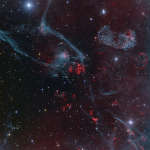 Puppis A Supernova Remnant
Puppis A Supernova Remnant
29.09.2017
Driven by the explosion of a massive star, supernova remnant Puppis A is blasting into the surrounding interstellar medium about 7,000 light-years away. At that distance, this colorful telescopic field based on broadband and narrowband optical image data is about 60 light-years across.
 Puppis A Supernova Remnant
Puppis A Supernova Remnant
28.08.2015
Driven by the explosion of a massive star, supernova remnant Puppis A is blasting into the surrounding interstellar medium about 7,000 light-years away. At that distance, this colorful telescopic field based on broadband and narrowband optical image data is about 60 light-years across.
 Iridescent Clouds over Sweden
Iridescent Clouds over Sweden
15.01.2020
Why would these clouds multi-colored? A relatively rare phenomenon in clouds known as iridescence can bring up unusual colors vividly or even a whole spectrum of colors simultaneously. These polar stratospheric clouds clouds, also known as nacreous and mother-of-pearl clouds, are formed of small water droplets of nearly uniform size.
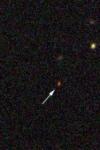 High Redshift Quasars
High Redshift Quasars
11.12.1998
Each red speck indicated above is a powerful quasar estimated to be over 100 times brighter than a galaxy. Yet in these Sloan Digital Sky Survey discovery images the quasars appear faint because they are extremely distant.
 A Powerful Solar Flare
A Powerful Solar Flare
29.10.2003
Yesterday, our Sun produced one of the most powerful solar flares in recorded history. Seen across the electromagnetic spectrum, the Sun briefly became over 100 times brighter in X-rays than normal. Over the next few days, as energetic particles emitted from these regions strike the Earth, satellite communications might be affected and auroras might develop.
 Gemini North Images Bow Shock Near Galactic Center
Gemini North Images Bow Shock Near Galactic Center
17.10.2000
What's going on near the center of our Galaxy? Glowing across the electromagnetic spectrum, the center of our Milky Way Galaxy is thought to be home to massive stars, rotating gas rings, and a massive black hole. Now the central Galactic zoo just got larger.
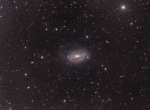 M63: Sunflower Galaxy Wide Field
M63: Sunflower Galaxy Wide Field
4.08.2016
The Sunflower Galaxy blooms near the center of this wide field telescopic view. The scene spans about 2 degrees or 4 full moons on the sky toward the loyal constellation Canes Venatici. More formally...
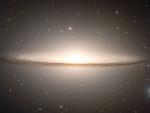 The Sombrero Galaxy from VLT
The Sombrero Galaxy from VLT
28.02.2000
Why does the Sombrero Galaxy look like a hat? Reasons include the Sombrero's unusually large and extended central bulge of stars, and dark prominent dust lanes that appear in a disk that we see nearly edge-on. Billions of old stars cause the diffuse glow of the extended central bulge.
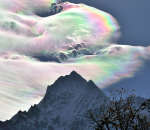 Iridescent Clouds over Thamserku
Iridescent Clouds over Thamserku
8.07.2014
Why would a cloud appear to be different colors? A relatively rare phenomenon known as iridescent clouds can show unusual colors vividly or a whole spectrum of colors simultaneously. These clouds are formed of small water droplets of nearly uniform size.
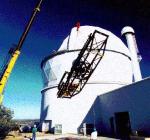 HET: The New Largest Optical Telescope
HET: The New Largest Optical Telescope
27.12.1996
Most of our universe is too dim to see. To peer into our cosmos' unknown depths, astronomers must deploy new tools - and the classic new tool is a larger telescope. Pictured above is the new Hobby-Eberly Telescope (HET) which recently declared "first light" in western Texas.
|
January February March April May |
|||||||||||||||||||||||||||||||||||||||||||||||||